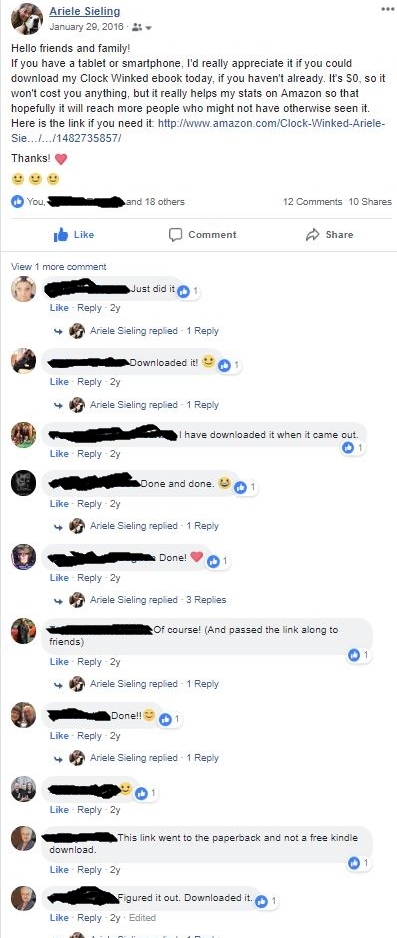The next installment in my fake master’s degree (click here to learn more about what I’m talking about), was a book titled Influence: The Psychology of Persuasion by Dr. Robert Cialdini. He details six so-called “Weapons of Influence” that people, corporations, and marketers use on each other, sometimes intentionally and sometimes not. He also uses the concepts to explain why we may make apparently irrational decisions. I found it fascinating to say the least, and thoroughly enjoyed the read. My assignment (click here for a refresher on my assignments), was to read the book and then write an essay discussing some of the concepts in the book and how they relate to my marketing tactics.
Below you will find my 5 to 7 page paper (let’s be real, it was a lot closer to 7 pages haha) in its entirety. Enjoy! (if you like psychology, that is)
RECIPROCITY, SOCIAL PROOF, AND SCARCITY: THE ETHICAL MARKETER
Marketing is tricky business. Even the subtlest tactics can have a positive or negative impact on the way a person views you or your product; this can then have a ripple effect, impacting not only whether or not they make a purchase, but how they feel about you and your product. In the book, Influence: The Psychology of Persuasion, Dr. Robert Cialdini details six automatic behavior patterns that can help explain why a person makes seemingly irrational choices. In this essay, I will review three of the patterns: reciprocity, social proof, and scarcity. Then I will provide real-life instances when I have encountered each during the course of selling books.
The rule of reciprocity is simple. According to Dr. Cialdini, “the rule says we should try to repay, in kind, what another person has provided for us.”[1] That means that if a friend, family member, or even a stranger does something for us, we feel a need return the favor. This obligation can be overwhelming. Dr. Cialdini describes an instance in which a woman is unable to start her car, and a nearby young man offers to give her a jump.[2] She thanks him, and then offers to do him a favor in return. A month later, the young man knocks on her door and asks if he can borrow her car, since his is in the shop. She is so bound by the weight of the obligation to reciprocate the favor, that she loans him (a complete stranger) her car, only to have him total it. The law of reciprocity can cause individuals to make decisions that they know are poor; they might not even understand why they are making the choice. It is also a weakness that marketers leverage to try to manipulate people into purchasing a product or making a donation to a cause. Think of the mail you receive from large non-profits. Many of them send address labels, coins, and small gifts—simply with the hope that you will return the favor. But I would argue that knowingly triggering a person’s automatic behaviors for your own gain is unethical, especially if what you’re offering in exchange is essentially worthless.
I have seen the law of reciprocity in action in my own attempts to sell books. During comic cons and other events, I will occasionally do a promotion where I give away a free book in exchange for someone signing up for my newsletter. This nearly always works: the exchange is simple, and in the customer’s favor. Multiple times, I have offered someone a free book, only to have them turn around and buy the entire series, or at very least try to pay for the book I am offering them for free. This is the law of reciprocity in action. Even more surprising is when I give away buttons. They are simple, cheap, and have silly drawings on them. I put them on my table as a way to get people to come and talk to me, and have no expectation for reciprocation. The buttons have sold more books for me than any other in-person marketing tactic. The person takes a button, spends a few minutes looking at my work, and decides to buy a book—if not for him/herself, then for a friend. I even had one person offer to pay $10 for a button—the same price as a book! I offered her a book, but she refused—she just wanted the button and to support a local author, she said.
The principle of social proof “states that one means we use to determine what is correct is to find out what other people think is correct… we view a behavior as more correct in a given situation to the degree that we see others performing it.”[3] Dr. Cialdini points to several major events in recent history that clearly call out the impact of social proof, but the one that stood out to me the most was the case of Catherine Genovese. In March, 1964, Catherine Genovese was walking in Kew Gardens, Queens, where she was stalked and stabbed in three separate attacks. Thirty-eight people witnessed the event, and yet not one of them called the police. Cialdini suggests that one of the main reasons for this was social proof: each of the thirty-eight people was uncertain of how to respond, and looked to the others around them for guidance. But they were all looking to each other and so no one acted, assuming incorrectly that if something should be done, someone else had already done it.[4] He cites two researchers, Latané and Darley, who asserted that, “no one had helped precisely because there were so many observers… with several potential helpers around, the personal responsibility of each individual [was] reduced.”[5]
Social proof can be faked, unfortunately. Set up a table at an event and hire actors to come wax eloquent about your product. Draft an ad for TV where an “expert” comes to speak about your product, thusly convincing viewers that the product is of value. Dr. Cialdini references a historical example of two men named Sauton and Porcher who hired people to come in and applaud during opera performances.[6] Modern day canned laugh tracks is another example of this. Commercial producers will even hire actors to give fake testimonials about a product, to convince viewers that “normal” people like and use the products. It can be extremely obvious, and yet it still works because social proof is nothing more than a mental shortcut. [7]
Look at all these nice people.
A couple of years ago, I ran a free book promotion through Amazon. I dropped the price of the second book in my series, The Clock Winked, down to $0.00 for a period of five days. Within the first twenty-four hours, I had over a thousand downloads, which was a huge number for me at that time (compared to my average paid sales which were 0 - 3 downloads per day, and the highest number of downloads I’d ever had in one day being 40). So I posted on Facebook to share my success with my friends, explaining that the higher the number of downloads, the greater the impact would be on Amazon’s ranking algorithm. I concluded with a request for them to download the book if they hadn’t already done so. Within the next couple of hours, I had dozens of likes, comments, and shares on my post (with subsequent likes, comments and shares on the shared posts), dozens more downloads, and even an outpouring of support for the book, with people commenting or messaging me that they had read and enjoyed it, and were looking forward to reading the rest of the series. (My total downloads for the five-day period ended up at around 3500, and my highest rank was #3 on Amazon free books.)
This type of support is incredibly difficult to garner in the writing world. Reading is not the most popular sport, and even when friends and family choose to read the work you’ve published, they rarely take the extra step to offer encouragement. I believe that the reason there was such a sudden influx of support was because of the principle of social proof. If thousands of people were downloading my book, it must be worth reading, even though none of those thousands of individuals had actually read it. Simply by reading my statement that I was having a successful day, others were motivated to participate (aided, presumably, by the buy-in cost of $0).
Scarcity, the idea that “opportunities seem more valuable to us when their availability is limited,”[8] is a particularly powerful motivator. It explains why misprinted money, which should seemingly be less valuable, actually becomes more valuable. It explains why bread sells out at the grocery store before a storm rolls in. It explains why people will go to such lengths to acquire rare Pokémon or Beanie Babies or collectibles, even when such items have no practical value. This concept is most easily seen in marketing campaigns that use phrases like, “Limited Time Only!” or “Only 100 copies in print!” or “Sold Out!” Think of the ever-scrupulous car salesman that has his manager on the phone, and if you “Buy Now!” he can get you a deal on that old clunker you brought to trade in.
Cialdini cites the story of the vice president of prime-time programming for American Broadcasting Company in 1963. The only showing of the movie, A Poseidon Adventure, was placed up for auction. He was competing against CBS and NBC. They went back and forth until ABC won the movie for $2 million, a price so high they couldn’t hope to make it back in ticket sales.[9] Scarcity plus rivalry can make even the smartest man a fool. Dr. Cialdini says, “it is instructive to note that the smiling man was the one who had lost the highly sought-after prize. As a general rule, whenever the dust settles and we find losers looking and speaking like winners (and vice versa), we should be especially wary of the conditions that kicked up the dust…”[10]
Before I even knew what the scarcity principle was, I had an idea: whenever I got down to my last copy of a book, put a sign up that said, “Last Copy.” It never fails. To this day, as soon as I put up a sign that says, “Last Copy” at an event, the book sells within the hour. But my most remarkable story of scarcity, one that still boggles my mind, is in regards to my more recent book, Tentacles and Teeth. I had decided to release the book one chapter at a time on Patreon, so even though the book had been completed, it was not actually available for general purchase. When I launched my Patreon, I made a big fuss through email, social media, and advertising, and made everyone aware of this new project. Then, I had 50 copies of the book printed. I labeled them as “pre-pre-release edition copies” and set them on my table at double the price of the rest of my other books. My reasoning was that I didn’t want my Patreon subscribers to feel jipped because I was out selling the books while they had to wait for each chapter, but if I sold it for double the actual price, the subscribers would be getting it at a 50% discount. I didn’t expect them to sell, but figured it was worth the cost of production, if only to get a few more eyes on the product.
The price didn’t seem to matter. Within three events (I had four scheduled), I had sold out of every copy, including my proof copy, which went for three times the price of my other books. With success like that, it’s no wonder marketers are tempted to create artificial scarcity to boost sales.
So how can you use these strategies for your marketing without being manipulative? Without lying, falsifying, or cheating your audience? I would argue that the key is in the truth. Are you telling the truth when you say a product is scarce? Are you creating a product that people can genuinely get excited about and share with their friends? Are you offering a free book because you honestly want to provide something of value to potential customers?
I think it’s important to remember that everything reflects back on you, the author. Every marketing tactic you try, everything you say, and everything you do shines light on who you are as a person and as a business. If you lie, falsify evidence, or try to manipulate your audience into buying your books, it might work for a time, but eventually, people will come to see you for who you really are. As authors, we aren’t big corporations that can hide behind “corrupt CEOs” and “I didn’t know my employees were doing that.” It’s just us. Me. You. We are responsible for the words we write on the page, the actions of the people that work for us, and the stories we tell in our marketing.
So don’t be a creep. Or, in the words of Macklemore & Ryan Lewis:
“Make the money, don't let the money make you
Change the game, don't let the game change you
I’ll forever remain faithful
Stay true, stay true, stay true.”[11]
———————————
[1] Robert Cialdini, Influence: The Psychology of Persuasion (Collins, 2007), 17.
[2] Cialdini, Influence: The Psychology of Persuasion, 34.
[3] Cialdini, Influence: The Psychology of Persuasion, 116.
[4] Cialdini, Influence: The Psychology of Persuasion, 130.
[5] Cialdini, Influence: The Psychology of Persuasion, 132.
[6] Cialdini, Influence: The Psychology of Persuasion, 158 - 159.
[7] Cialdini, Influence: The Psychology of Persuasion, 160.
[8] Cialdini, Influence: The Psychology of Persuasion, 238.
[9] Cialdini, Influence: The Psychology of Persuasion, 264 - 265.
[10] Cialdini, Influence: The Psychology of Persuasion, 265.
[11] Macklemore, “Make the Money,” Macklemore LLC, ADA, 2012.
















![IMG_6118[1].JPG](https://images.squarespace-cdn.com/content/v1/53be9276e4b0dd42b6f447cb/1537894465511-5IOHO8OBFXUJ88CRZV05/IMG_6118%5B1%5D.JPG)
![IMG_6119[1].JPG](https://images.squarespace-cdn.com/content/v1/53be9276e4b0dd42b6f447cb/1537895091547-B5WPMS26UV5BCA9ZVZFJ/IMG_6119%5B1%5D.JPG)






